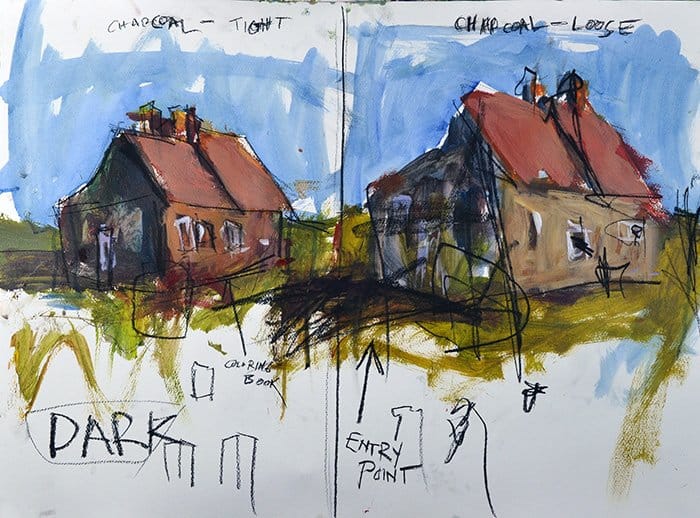Avoid This Common Drawing Mistake - Paint Loose
Most beginners fall into the “coloring book” trap — tracing every edge of their subject. Learn how to avoid this mistake and replace it with loose, expressive lines that add life and energy to your drawings.

I see it happen all the time — artists fall into the coloring book trap. Instead of letting lines flow naturally, they start tracing every single edge of their subject. It feels safe, but the result is stiff, predictable, and lifeless.
This post will show you the difference between tracing outlines versus using lines expressively — and how a simple shift in approach makes your drawings (and paintings) instantly more engaging.
👉 Four Ways To Start and Expressive Painting - fresh ideas to begin your art
The “Coloring Book” Mistake
An experienced artist might pick up compressed charcoal, a crayon, or even a brush and then… trace.
- Outlining every window, chimney, and roof.
- Locking into repetitive details.
- Making every line the same thickness.
It’s a common habit, but it leaves your work flat — more like a coloring book page than an expressive drawing.

The Loose & Expressive Alternative
Instead of tracing, think organically:
- Find entry points in the darks. Start where shadows live and let lines grow outward.
- Vary your line quality. Use the broad side of charcoal, then switch to the point for accents. Mix thin and thick strokes.
- Skip details on purpose. Suggest a window with one energetic squiggle instead of tracing the whole frame.
This way, your lines feel unpredictable and fearless — they breathe life into the painting.
Garage Studio Drill
- Paint or sketch a simple house.
- On the left side, trace every detail (windows, roof, chimney).
- On the right side, use expressive lines:
- Start in the shadows.
- Scribble with varied pressure.
- Suggest detail without tracing.
- Step back: which side has more energy?
👉 Most artists find the looser side draws the eye first — because it carries rhythm, variety, and personality.
Why It Works
- Predictable lines = boring.
- Expressive, varied lines = attention-grabbing.
- Entry points in the darks keep your strokes integrated with the painting, not pasted on top.
In short: don’t trace your art — dance with it.
Next Steps
Try this in your next sketch or painting:
- Add charcoal or crayon on top of dry paint.
- Avoid “outlining” everything.
- Let some lines wander, skip, or break.
Your work will feel loose, expressive, and much more alive.
Learn & Improve Your Acrylic Skills
- Acrylic Hub– Your go-to guide for tutorials, tips, and resources.
- Subscribe for More Great Content - Get tutorials, tips, and updates straight to your inbox.
- Follow Me on Pinterest - Daily inspiration, tips, and fresh ideas.
Recommended Acrylic Painting Materials
-
Princeton Catalyst Brushes – Flats (#6, #12), Rounds (#4, #8), Fan (#4), Liner Brush
Durable synthetic bristles for versatile acrylic techniques -
Liquitex Heavy Body Acrylic Paint – Essential Colors
Cadmium Yellow, Yellow Ochre, Alizarin Crimson, Cadmium Red Light, Ultramarine Blue, Cobalt Blue, Burnt Sienna, Titanium White -
Winsor & Newton Cotton Canvas
Reliable stretched canvas for studio and plein air work -
Strathmore 400 Series Mixed Media Paper
Heavyweight, acid-free paper for acrylic and mixed media -
Fabriano Artistico 140lb Cold Press Paper
Excellent for acrylic, mixed media, and textured effects -
Blick Multi-Colored Painting Knife Set
Variety of shapes for texture, scraping, and bold strokes - Miscellaneous: Two pint-sized water containers, paper towels (from Home Depot or Walmart)
- Note: I use canvas or sturdy cardboard as my palette — no store-bought palettes needed.




